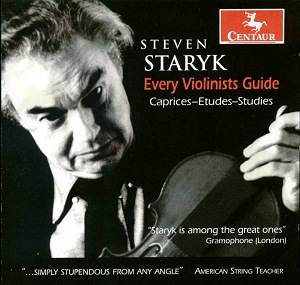|
|
Search MusicWeb Here |
|
 |
||
|
Founder:
Len Mullenger (1942-2025) Editor
in Chief:John Quinn
|
|
|
Search MusicWeb Here |
|
 |
||
|
Founder:
Len Mullenger (1942-2025) Editor
in Chief:John Quinn
|

Buy
through MusicWeb for
£12.95 postage
paid
World-wide.
Immediate delivery
|
Every Violinist’s
Guide - Thirty Four Traditional Caprices, Etudes
and Studies Rudolf KREUTZER (1766-1831) Etude No. 2 Op. 16 [0.46] Etude No. 35 Op. 16 [2.49] Etude No. 8 Op. 16 [1.16] Pierre RODE (1774-1830) Caprice No. 21 Op. 22 [2.58] Caprice No. 17 Op. 22 [1.39] Caprice No. 2 Op. 22 [1.30] Caprice No. 8 Op. 22 [1.53] Federigo FIORILLO (1755-1823) Caprice No. 14 Op 3 [1.54] Caprice No. 28 Op. 3 [1.58] Caprice No. 3 Op. 3 [1.08] Niccolo PAGANINI (1782-1840) Caprice No. 19 Op. 1 [2.38] Caprice No. 9 Op. 1 [2.36] Caprice No. 14 Op. 1 [1.06] Caprice No. 16 Op. 1 [1.25] Caprice No. 21 Op. 1 [3.20] Caprice No. 20 Op. 1 [3.05] Caprice No. 5 Op. 1 [2.18] Caprice No. 24 Op. 1 [4.38] Henryk WIENIAWSKI (1835-1880) Etude No. 7 Op. 10 [4.10] Etude No. 1 Op. 10 [0.36] Etude No. 5 Op. 10 [1.43] Jakob DONT (1815-1888) Caprice No. 2 Op. 35 [1.28] E. POLO (1869-1953) 30 Double Stops Studies No. 4 [1.19] Otakar SEVCIK (1852-1934) Variation Nos 21-24 Op. 2 Part 2 [2.14] Variation No. 34 Op. 3 [0.37] Charles DANCLA (1817-1902) Caprice Mo.9 Op. 52 [1.06] Caprice No. 16 Op. 52 [1.35] J.F. MAZAS (1782-1849) Study No. 8 Op. 36 [2.30] H.E. KAYSER (1815-1888) Study No. 4 Op. 20 [1.09] Franz SCHUBERT (1808-1878) L’Abeille (The Bee) No. 9 Op. 13 [1.09] Pietro LOCATELLI (1695-17640 Caprice No. 2 Op. 3 [3.29] Caprice No. 20 Op. 3 [1.56] Caprice No,23 Op. 3 [3.35] H. SCHRADIECK (1846-1918) Section 3 No. 12 [1.11] Recorded in 1963, 1969 and 2003 |
Error processing SSI file |
|
|
Return to Index |